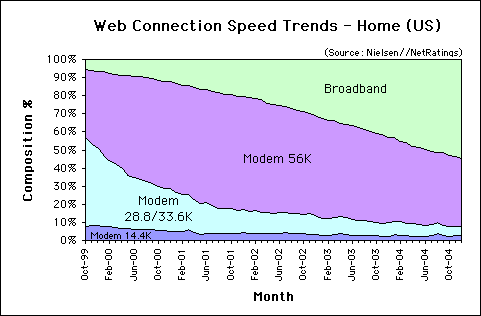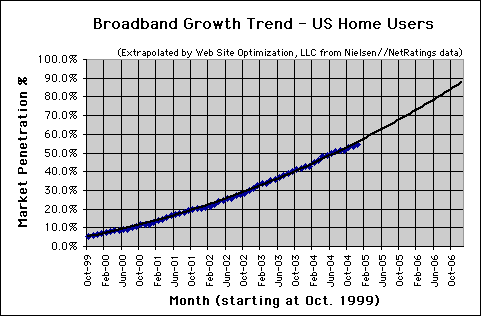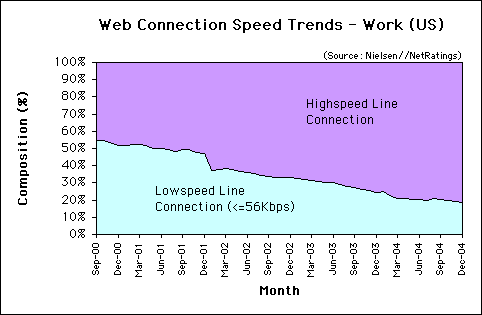The number of broadband users in U.S. homes increased by 35.9% in 2004. The growth of broadband users in the home outpaced the growth at work by 14.5%. In December, broadband penetration among active Internet users in the U.S. grew by 1.1 percentage points to 54.69%. 45.31% of US home users dial into the Internet with “narrowband” connections of 56Kbps or less.
The charts below, derived from Nielsen//NetRatings data, show trends in connection speeds to the Internet for United States users.*
Home Connectivity in the US
In December 2004, most active Internet users connect from home with broadband connections. Among narrowband users, 37.71% use 56Kbps modems, 4.85% use 28/33.3Kbps, and 2.75% use 14.4Kbps modems. In total, 45.31% of home users in the US connect to the Internet at 56Kbps or less (see Figure 1).
Web Connection Speed Trends – Home Users (US)
Figure 1: Web Connection Speed Trends – Home Users (US)
Source: Nielsen//NetRatings
Broadband Growth in the US
Broadband penetration in the US grew by 1.1 points to 54.69% in December, up from 53.59% in November. This increase is above the average increase in broadband of 1.0 point per month over the previous twelve months. Broadband share in the US should exceed 70% by December of 2005 (see Figure 2).
Broadband Connection Speed Trend – Home Users (US)
Figure 2: Broadband Connection Speed Trend – Home Users (US)
Extrapolated from Nielsen//NetRatings data
Work Connectivity
Most workers in the US enjoy high-speed connections to the Internet. Most use a high-speed line such as a T1 connection, and share bandwidth between computers connected to an Ethernet network. The speed of each connection decreases as more employees hook up to the LAN. As of December of 2004, of those connected to the Internet, 81.39% of US users at work enjoy a high-speed connection, up 0.49 percentage points from 80.9% in November. At work, 18.61% connect at 56Kbps or less (see Figure 3).
Web Connection Speed Trends – Work Users (US)
Figure 3: Web Connection Speed Trends – Work Users (US)
Source: Nielsen//NetRatings
U.S. Broadband Users Up 35.9% in 2004
Over the past year, the number of broadband users in US homes grew by over 35.9%, according to figures provided by Nielsen//NetRatings. The growth in broadband users at work grew by 21.4%, trailing the growth rate in US homes by 14.5% (see Table 1). This lower growth rate is understandable, given the higher broadband penetration rate at work of 81.4%. Overall, U.S. broadband penetration grew by 11.84 percentage points from 42.85% in December 2003 to 54.69% in December 2004. Meanwhile over in the United Kingdom takeup has nearly doubled. The Register reports that by summer 2005, 99.6% of British homes and businesses will have access to DSL-based broadband.
Growth in Broadband Users (U.S., Unique Audience)
| Location | Dec. 2003 | Dec. 2004 | Increase |
|---|---|---|---|
| Home | 51,096,054 | 69,431,802 | 35.9% |
| Work | 34,732,004 | 42,165,169 | 21.4% |
Source: Nielsen//NetRatings
Further Reading
- 2004: The year of British Broadband
- The Register reports that it has been a good year for broadband in the UK. “Take-up has almost doubled; charges have continued to fall, breaking the all important £20 a month price point; and more of us can hook up to it – if that’s what we want.” BT reports that 99.6% of British homes and business should have access to DSL-based broadband by summer 2005. The Register, Dec. 23, 2005.
- FCC: High-speed connections up in 2004
- The FCC reports that high-speed connections in the US were up by 15% in the first half of 2004. CNET News.com, Jan. 4, 2005.
- January 2004 Bandwidth Report – US Broadband Penetration Jumps to 42.85% – US Ranks 11th Worldwide
- Broadband adoption jumped to 42.85% in December, up 1.31% from 41.54% in November 2003. 57.15% of U.S. home users connect to the Internet with connections of 56Kbps or less. Broadband usage at U.S. firms jumped to 75.7%, up 1.5% from 74.2% in November. The January 2004 Bandwidth Report.
- Top Broadband States Still Among the Wealthiest
- Bruce Leichtman estimates that the overall broadband penetration rate in the U.S. is now 28%. This is residential and small business subscribers divided by US Postal Service addresses as of the beginning of July 2004 extrapolated to the present day.
Leichtman Research Group, Jan. 11, 2005 - Nielsen//NetRatings
- Provides the US broadband data (percentage of active Internet users) for the Bandwidth Report.
*Note that Nielsen//NetRatings reports the percentage of active Internet users that use broadband from home, not broadband households. NetRatings uses a panel of 40,000 to 50,000 people with software meters installed on their computers. These meters detect connection speeds. Each month they do an enumeration study to call a number of people to calibrate the panel by adjusting weightings to match the population at large.



